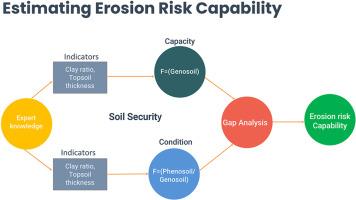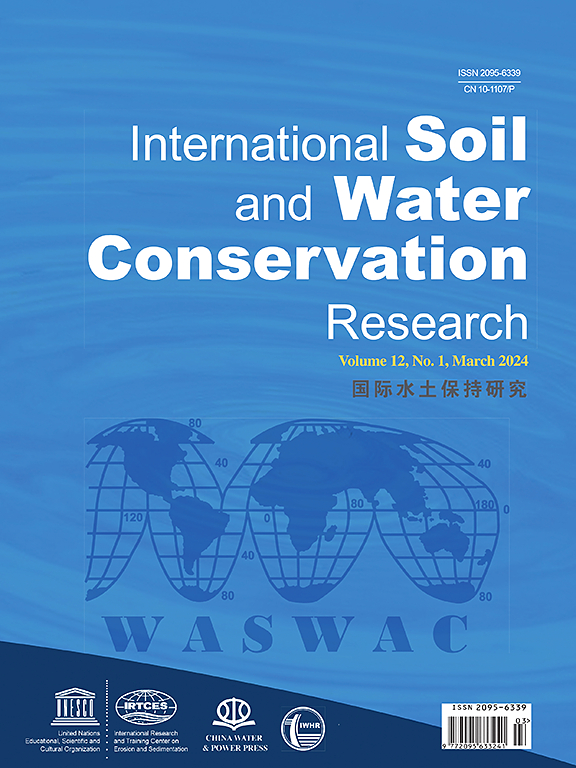Assessing soil erosion vulnerability using a novel capacity–condition framework (CCF): A case study from New South Wales, Australia
IF 7.3
1区 农林科学
Q1 ENVIRONMENTAL SCIENCES
International Soil and Water Conservation Research
Pub Date : 2025-07-05
DOI:10.1016/j.iswcr.2025.07.002
引用次数: 0
Abstract
Soil water erosion is a major threat to long-term soil sustainability. However, challenges remain in capturing how both natural and human-induced erosion processes interact over space and time to influence soil degradation. Current assessment methods often overlook how erosion simultaneously weakens the soil's inherent resistance (capacity) and degrades its current state (condition)-key drivers of long-term vulnerability and two core dimensions of soil security. To address this, we present a Capacity-Condition (CCF) framework, which quantifies erosion vulnerability using the erosion risk capability metric, which captures the gap between a soil's inherent resistance to erosion (capacity) and its erosion-altered state (condition). The framework employs the pedogeonon concept, identifying unique landscape units where the same soil-forming factors operate over time. Within each pedogeonon, two soil states are compared: genosoil (conditions influenced by natural erosion) and phenosoil (present state shaped by both natural and human-accelerated erosion). Capacity is assessed using genosoil indicators (clay ratio and topsoil thickness), and condition is evaluated using the phenosoil/genosoil ratio for the same indicators. Utility functions standardize these indicators on a 0–1 scale, enabling their aggregation into composite scores. When applied to New South Wales (NSW), Australia, the framework identified regions most vulnerable to erosion. Coastal areas and the upper northwest, characterized by intensive dry cropping and grazing on modified pastures, exhibited the highest risk values, indicating a lower capability to withstand future erosion. Conversely, regions with mixed land use-including grazing on native vegetation, intensive horticulture, and irrigated cropping-showed moderate risk, demonstrating the framework's utility for targeted, spatially explicit soil conservation and land management planning.

利用新型能力条件框架(CCF)评估土壤侵蚀脆弱性:以澳大利亚新南威尔士州为例
水土流失是土壤长期可持续性的主要威胁。然而,在了解自然和人为侵蚀过程如何在空间和时间上相互作用从而影响土壤退化方面仍然存在挑战。目前的评估方法往往忽略了侵蚀如何同时削弱土壤的内在抵抗力(能力)和恶化其当前状态(条件)——长期脆弱性的关键驱动因素和土壤安全的两个核心维度。为了解决这个问题,我们提出了一个容量-条件(CCF)框架,该框架使用侵蚀风险能力度量来量化侵蚀脆弱性,该度量捕获了土壤固有的抗侵蚀能力(能力)与其侵蚀改变状态(条件)之间的差距。该框架采用了土壤的概念,确定了独特的景观单元,其中相同的土壤形成因素随着时间的推移而起作用。在每个土壤区内,比较了两种土壤状态:基因土壤(受自然侵蚀影响的条件)和表型土壤(由自然和人为加速侵蚀形成的现状)。利用基因土壤指标(粘土比和表土厚度)评估能力,并利用相同指标的表型土壤/基因土壤比评估条件。效用函数将这些指标按0-1的等级进行标准化,使其能够聚合成综合分数。当应用于澳大利亚新南威尔士州(NSW)时,该框架确定了最容易受到侵蚀的地区。沿海地区和西北北部以集约旱作和改良草场放牧为特征,其风险值最高,表明其抵御未来侵蚀的能力较低。相反,混合土地利用(包括放牧原生植被、集约化园艺和灌溉种植)的地区显示出中等风险,这表明该框架在有针对性的、空间明确的土壤保持和土地管理规划方面具有实用价值。
本文章由计算机程序翻译,如有差异,请以英文原文为准。
求助全文
约1分钟内获得全文
求助全文
来源期刊

International Soil and Water Conservation Research
Agricultural and Biological Sciences-Agronomy and Crop Science
CiteScore
12.00
自引率
3.10%
发文量
171
审稿时长
49 days
期刊介绍:
The International Soil and Water Conservation Research (ISWCR), the official journal of World Association of Soil and Water Conservation (WASWAC) http://www.waswac.org, is a multidisciplinary journal of soil and water conservation research, practice, policy, and perspectives. It aims to disseminate new knowledge and promote the practice of soil and water conservation.
The scope of International Soil and Water Conservation Research includes research, strategies, and technologies for prediction, prevention, and protection of soil and water resources. It deals with identification, characterization, and modeling; dynamic monitoring and evaluation; assessment and management of conservation practice and creation and implementation of quality standards.
Examples of appropriate topical areas include (but are not limited to):
• Conservation models, tools, and technologies
• Conservation agricultural
• Soil health resources, indicators, assessment, and management
• Land degradation
• Sustainable development
• Soil erosion and its control
• Soil erosion processes
• Water resources assessment and management
• Watershed management
• Soil erosion models
• Literature review on topics related soil and water conservation research
 求助内容:
求助内容: 应助结果提醒方式:
应助结果提醒方式:


